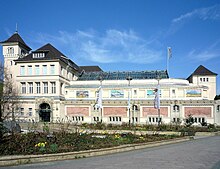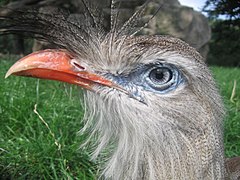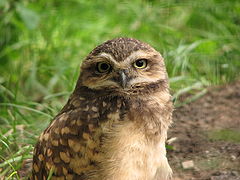Berlin Zoo: Difference between revisions
m (GR) File renamed: File:Gro er Panda Bao Bao Berlin W 03.jpg → File:Großer Panda Bao Bao Berlin W 03.jpg File renaming criterion #3: To correct obvious errors in file names, including misspelled [[c... |
→History: moved paragraphs so they are chronological |
||
| Line 29: | Line 29: | ||
[[File:Actien-Verein des zoologischen Gartens 1909.JPG|thumb|left|Share of the zoo, issued 1. December 1909]] |
[[File:Actien-Verein des zoologischen Gartens 1909.JPG|thumb|left|Share of the zoo, issued 1. December 1909]] |
||
Opened on 1 August 1844, the Zoologischer Garten Berlin was the first zoo in Germany. The aquarium opened in 1913. The first animals were donated by [[Frederick William IV]], King of [[Prussia]], from the [[menagerie]] and pheasantry of the [[Großer Tiergarten|Tiergarten]]. |
Opened on 1 August 1844, the Zoologischer Garten Berlin was the first zoo in Germany. The aquarium opened in 1913. The first animals were donated by [[Frederick William IV]], King of [[Prussia]], from the [[menagerie]] and pheasantry of the [[Großer Tiergarten|Tiergarten]]. |
||
| ⚫ | During World War II, the zoo area was completely destroyed and only 91 of 3,715 animals survived, including two lions, two hyenas, an Asian bull elephant, a hippo bull, ten hamadryas baboons, a chimpanzee, and a black stork. By the end of the war, the zoo was fortified with the [[Zoo flak tower]], a huge [[Anti-aircraft warfare|flak tower]] that was one of the last remaining areas of German resistance against the [[Red Army]], with its bunkers and anti-aircraft weapons defending against [[Royal Air Force|allied air forces]]. Following the zoo's destruction, it and the associated Aquarium was reconstructed on the most modern principles so as to display the animals in as close to their natural environment as feasible. The success achieved in breeding animals, including some rare species, demonstrates the efficacy of these new methods.{{citation needed|date=January 2016}} |
||
In 1938, the Berlin Zoo got rid of Jewish board members and forced Jewish shareholders to sell their stocks at a loss, before re-selling the stocks in an effort to "Aryanize" the institution. The zoo has now commissioned a historian to identify these past shareholders and track down their descendants, according to a report by AFP.<ref>[http://www.haaretz.com/jewish-world/jewish-world-news/1.561521]</ref> |
In 1938, the Berlin Zoo got rid of Jewish board members and forced Jewish shareholders to sell their stocks at a loss, before re-selling the stocks in an effort to "Aryanize" the institution. The zoo has now commissioned a historian to identify these past shareholders and track down their descendants, according to a report by AFP.<ref>[http://www.haaretz.com/jewish-world/jewish-world-news/1.561521]</ref> |
||
| ⚫ | During World War II, the zoo area was completely destroyed and only 91 of 3,715 animals survived, including two lions, two hyenas, an Asian bull elephant, a hippo bull, ten hamadryas baboons, a chimpanzee, and a black stork. By the end of the war, the zoo was fortified with the [[Zoo flak tower]], a huge [[Anti-aircraft warfare|flak tower]] that was one of the last remaining areas of German resistance against the [[Red Army]], with its bunkers and anti-aircraft weapons defending against [[Royal Air Force|allied air forces]]. Following the zoo's destruction, it and the associated Aquarium was reconstructed on the most modern principles so as to display the animals in as close to their natural environment as feasible. The success achieved in breeding animals, including some rare species, demonstrates the efficacy of these new methods.{{citation needed|date=January 2016}} |
||
== Zoo == |
== Zoo == |
||
Revision as of 13:25, 14 August 2017
| Berlin Zoo | |
|---|---|
 The Elephant Gate: one of two zoo entrances | |
 | |
| 52°30′30″N 13°20′15″E / 52.50833°N 13.33750°E | |
| Date opened | 1844[1] |
| Location | Berlin, Germany |
| Land area | 35 hectares (86.5 acres)[1] |
| No. of animals | 18,662 (December 2016)[2] |
| No. of species | 1,380 (December 2016)[2] |
| Annual visitors | More than 3.3 million (2015)[2] |
| Memberships | EAZA,[3] WAZA[4] |
| Director | Andreas Knieriem |
| Website | http://www.zoo-berlin.de/ |
The Berlin Zoological Garden (German: Zoologischer Garten Berlin) is the oldest and best known zoo in Germany. Opened in 1844 it covers 35 hectares (86.5 acres) and is located in Berlin's Tiergarten. With about 1,380 different species and 18,662 animals the zoo presents one of the most comprehensive collection of species in the world.[2][5]
The zoo and its aquarium had more than 3.3 million visitors in 2015.[2] It is considered to be the most visited zoo in Europe and one of the most popular worldwide. Regular animal feedings are among its most famous attractions. Globally known animals like Knut, the polar bear, and Bao Bao, the giant panda have contributed to the zoo's public image (the zoo currently does have giant pandas since summer of 2017).[6]
The zoo collaborates with many universities, research institutes, and other zoos around the world. It maintains and promotes European breeding programmes, helps safeguard several endangered species, and participates in several species reintroduction programs.
History

Opened on 1 August 1844, the Zoologischer Garten Berlin was the first zoo in Germany. The aquarium opened in 1913. The first animals were donated by Frederick William IV, King of Prussia, from the menagerie and pheasantry of the Tiergarten.
In 1938, the Berlin Zoo got rid of Jewish board members and forced Jewish shareholders to sell their stocks at a loss, before re-selling the stocks in an effort to "Aryanize" the institution. The zoo has now commissioned a historian to identify these past shareholders and track down their descendants, according to a report by AFP.[7]
During World War II, the zoo area was completely destroyed and only 91 of 3,715 animals survived, including two lions, two hyenas, an Asian bull elephant, a hippo bull, ten hamadryas baboons, a chimpanzee, and a black stork. By the end of the war, the zoo was fortified with the Zoo flak tower, a huge flak tower that was one of the last remaining areas of German resistance against the Red Army, with its bunkers and anti-aircraft weapons defending against allied air forces. Following the zoo's destruction, it and the associated Aquarium was reconstructed on the most modern principles so as to display the animals in as close to their natural environment as feasible. The success achieved in breeding animals, including some rare species, demonstrates the efficacy of these new methods.[citation needed]
Zoo

| Group | Species[5] | Animals[5] |
|---|---|---|
| Mammals | 169 | 1,044 |
| Birds | 319 | 2,092 |
| Reptiles | 69 | 357 |
| Amphibians | 54 | 639 |
| Fish | 562 | 7,629 |
| Invertebrates | 331 | 8,604 |
| Total (2013) | 1,504 | 20,365 |
The Berlin Zoo is the most visited zoo in Europe, with more than 3.3 million visitors per year from all over the world.[2] It is open all year long and can easily be reached by public transportation. The Berlin Zoologischer Garten railway station (also simply known as Zoo) is one of Berlin's most important stations. Several modes of transport such as U-Bahn, S-Bahn and buses are interlinked here. Visitors can either enter the zoo through the exotically designed Elephant Gate beside the aquarium on Budapester Straße or through the Lion Gate on Hardenbergplatz.
The zoo maintains studbooks for black and Indian rhinoceroses and gaurs. The populations of rare deer and pigs are part of several captive breeding projects. Berlin Zoo supports conservationists in other countries (for instance, in Madagascar) and as a partner of the Stiftung Artenschutz (species protection foundation).
Most of the animals are housed in enclosures designed to recreate their natural habitat.
The zoo houses four types of great ape; orangutans, gorillas, chimpanzees, and bonobos.
The carnivore house displays all big cats and many rare small predators, such as ring-tailed mongooses and narrow-striped mongooses from Madagascar. In the basement, visitors are invited to a view into the world of nocturnal animals.
The bird house presents a walk-through aviary and offers a broad variety of forms, including several regularly breeding species of hornbills and many parrots. Numerous big aviaries show waders, herons and many other species. The Berlin Zoo is one of the few zoos to exhibit tuatara (in the aquarium) and Luzon tarictic hornbills.
Aquarium

The Aquarium, which was built in 1913 as part of the Zoologischer Garten complex.[8] In addition to fish and other aquatic life, it is home to most of the zoo's reptiles, amphibians and invertebrates.
Animals
The polar bear Knut was born in captivity at the zoo on 5 December 2006. Rejected by his mother at birth, he was subsequently raised by zookeepers and became the center of a mass media phenomenon that spanned the globe, quickly spawning numerous toys, media specials, DVDs, and books. Because of this, the cub was largely responsible for a significant increase in revenue, estimated at about five million euros, at the Berlin Zoo in 2007. Zoo attendance figures for the year increased by an estimated 30 percent making it the most profitable year in its 165-year history.[9] Knut died on 19 March 2011 after collapsing in his exhibit.
Bao Bao (born 1978) was the first giant panda in Germany and the eldest known giant panda in a zoo worldwide. Like many of his kind, he was on a permanent "loan" from China for breeding purposes. In spite of several artificial insemination experiments with a female named Yan Yan (who died in captivity in 2007), there were no offspring. Bao Bao died on 22 August 2012. The zoo will again display giant panda, beginning in the summer of 2017, when a pair are expected to arrive on breeding loan from China.[6]
Fatou the gorilla celebrated her 59th birthday on April 13. She came to the zoo at an estimated age of two. In 1974 she gave birth to the first gorilla to be raised in Berlin, Dufte.[10] Since the death of Colo in January 2017, she is the oldest living gorilla in the world (together with American gorilla Trudy).
-
Knut and his keeper Thomas Dörflein
-
Giant panda Bao Bao
-
Southern ostrich
Incidents
In 2009, a woman was mauled by polar bears after jumping into their exhibit. She was rushed to the hospital and survived.[11]
See also
- List of zoos in Germany
- Zoo flak tower, built in 1941, demolished in 1947
References
- ^ a b "Zoologischer Garten Berlin". zoo-infos.de. Zoo-Infos.de. Retrieved 5 September 2010.
- ^ a b c d e f "Zoologischer Garten Berlin's website".
- ^ "EAZA Member Zoos & Aquariums". eaza.net. European Association of Zoos and Aquaria. Retrieved 5 September 2010.
- ^ "Zoos and Aquariums of the World". waza.org. WAZA. Retrieved 5 September 2010.
- ^ a b c "Zoo Berlin Tierstatistik 2013". zoo-berlin.de (in German). Zoo Berlin. Retrieved 18 January 2014.
- ^ a b The Local (20 October 2016). Berlin Zoo to have a pair of pandas by next summer. Retrieved 23 April 2017.
- ^ [1]
- ^ "A brief introduction to Berlin Zoo". berlin-life.com. Berlin Life. Retrieved 5 September 2010.
- ^ Boyes, Roger (2007-12-13). "Berlin Zoo culls creator of the cult of Knut". timesonline.co.uk. London: The Times. Retrieved 6 September 2010.
- ^ "Zoo Berlin - Herzlich willkommen im Zoo Berlin. - Senior citizens meet for gorilla's birthday". www.zoo-berlin.de.
- ^ "Shocking pictures and video of woman mauled by polar bear at Berlin Zoo". http://www.mirror.co.uk/. Retrieved 20 September 2014.
{{cite web}}: External link in|website=






















